Management Accounting Report: HLW Club Cost and Revenue Analysis
VerifiedAdded on 2020/06/04
|12
|3066
|30
Report
AI Summary
This report delves into management accounting, focusing on Activity-Based Costing (ABC) and budgeting. Part A explains ABC, its factors, advantages, and disadvantages, followed by a cost analysis using activity drivers for various activities like invoices, purchase orders, and sales orders. A bill of activities and cost per unit for lamington is also provided. Part B examines budgeting, its influence on business decisions, and limitations. It further analyzes a new membership plan and fee structure for HLW club, estimating its impact on cash receipts and sales revenue. The report concludes with an assessment of the new plan's effectiveness in financial planning and management.
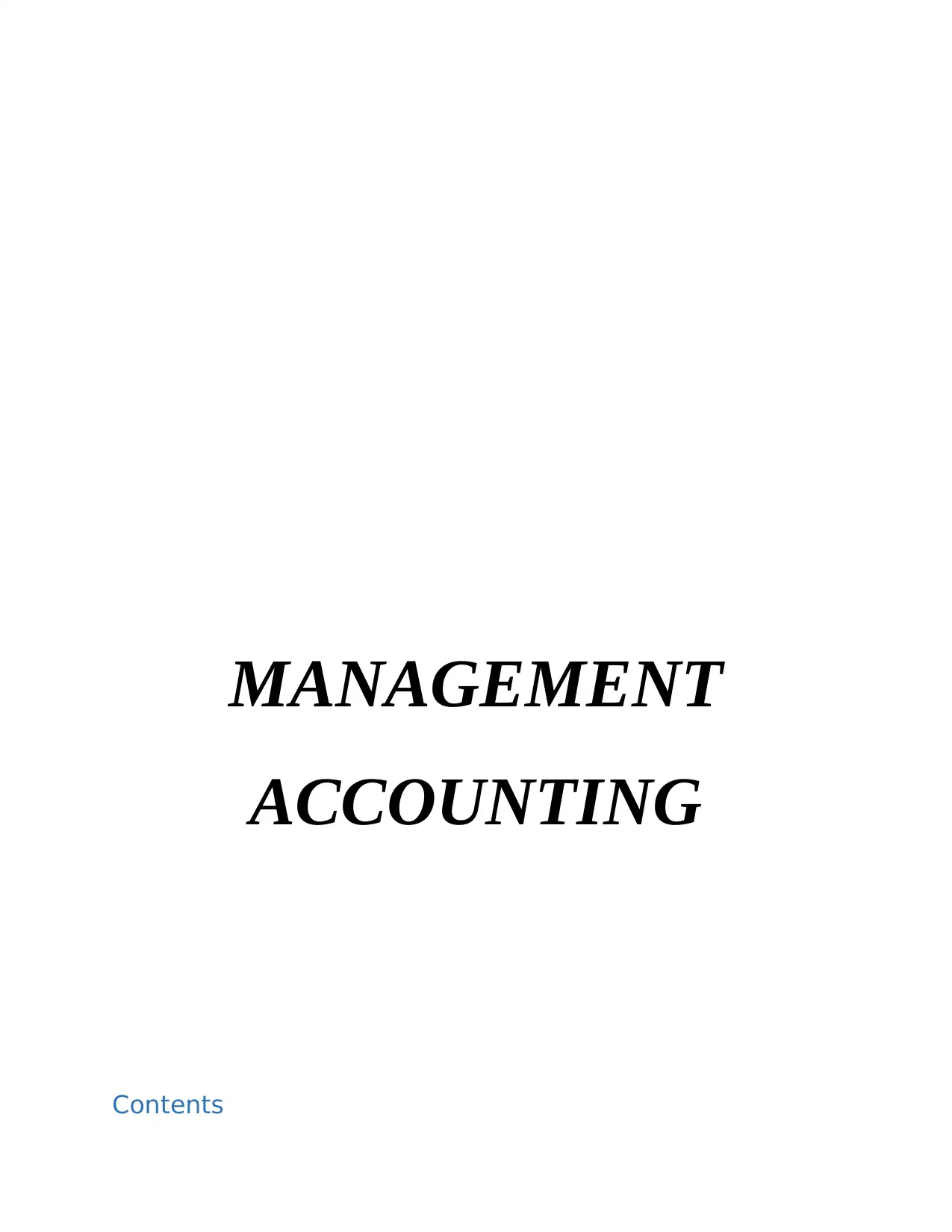
MANAGEMENT
ACCOUNTING
Contents
ACCOUNTING
Contents
Paraphrase This Document
Need a fresh take? Get an instant paraphrase of this document with our AI Paraphraser
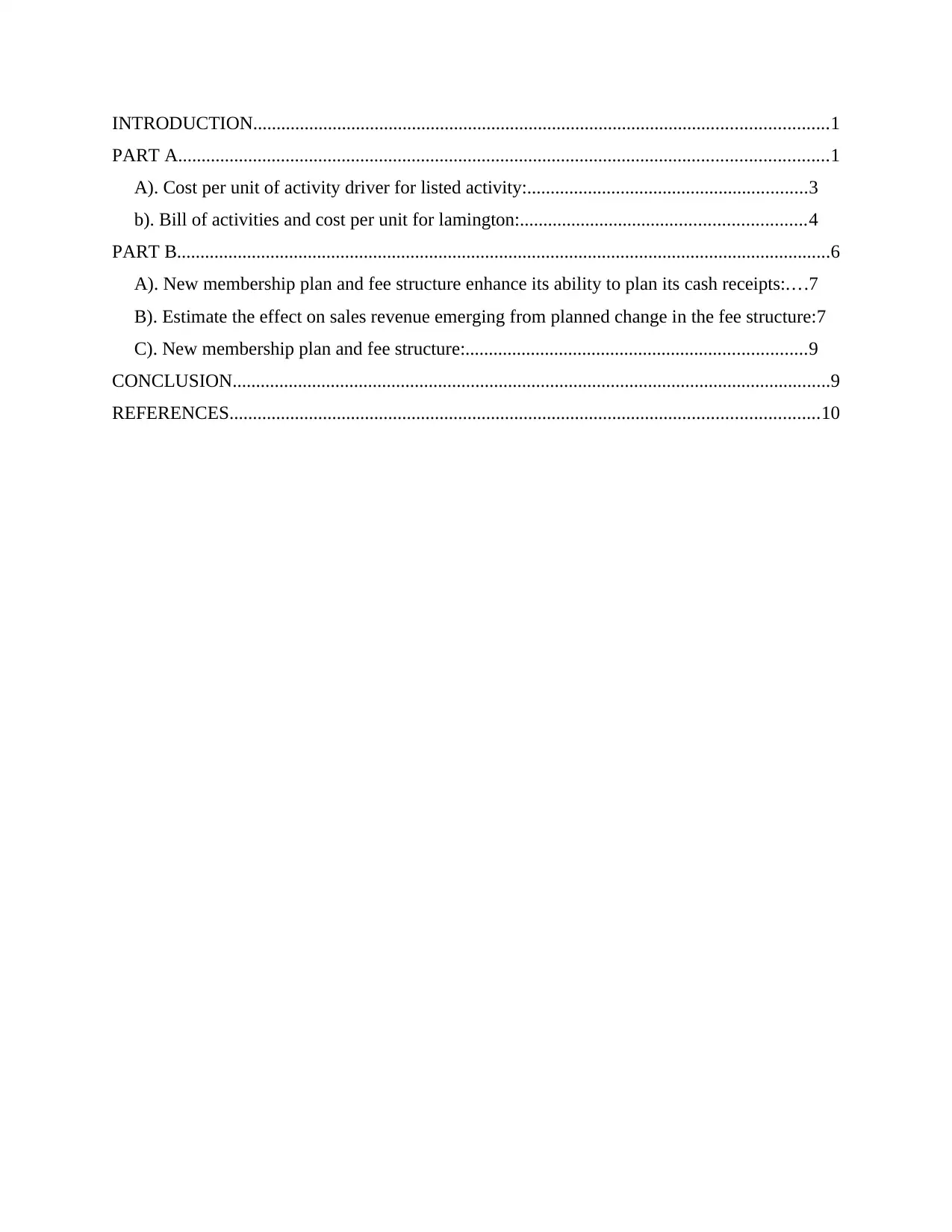
INTRODUCTION...........................................................................................................................1
PART A...........................................................................................................................................1
A). Cost per unit of activity driver for listed activity:............................................................3
b). Bill of activities and cost per unit for lamington:.............................................................4
PART B............................................................................................................................................6
A). New membership plan and fee structure enhance its ability to plan its cash receipts:....7
B). Estimate the effect on sales revenue emerging from planned change in the fee structure:7
C). New membership plan and fee structure:.........................................................................9
CONCLUSION................................................................................................................................9
REFERENCES..............................................................................................................................10
PART A...........................................................................................................................................1
A). Cost per unit of activity driver for listed activity:............................................................3
b). Bill of activities and cost per unit for lamington:.............................................................4
PART B............................................................................................................................................6
A). New membership plan and fee structure enhance its ability to plan its cash receipts:....7
B). Estimate the effect on sales revenue emerging from planned change in the fee structure:7
C). New membership plan and fee structure:.........................................................................9
CONCLUSION................................................................................................................................9
REFERENCES..............................................................................................................................10
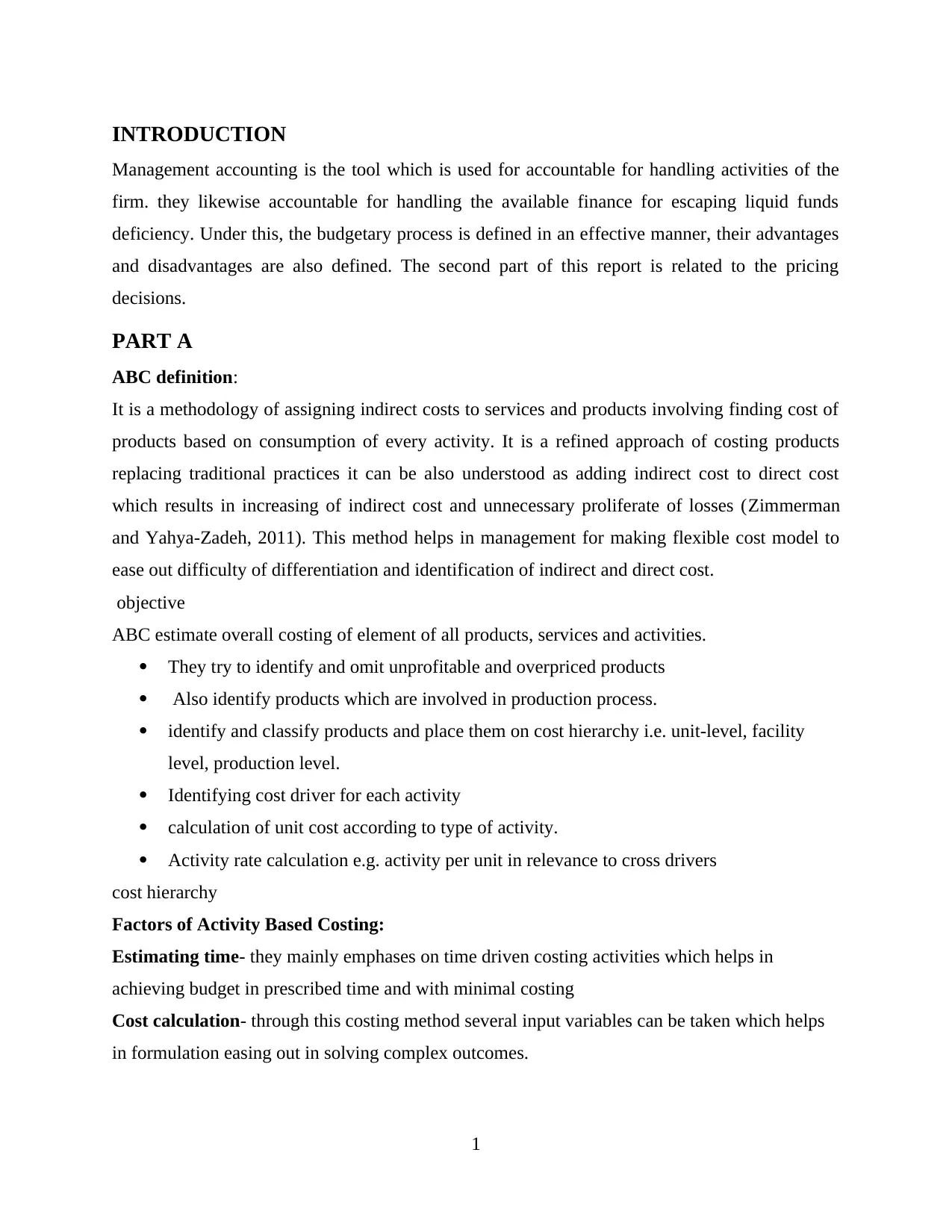
INTRODUCTION
Management accounting is the tool which is used for accountable for handling activities of the
firm. they likewise accountable for handling the available finance for escaping liquid funds
deficiency. Under this, the budgetary process is defined in an effective manner, their advantages
and disadvantages are also defined. The second part of this report is related to the pricing
decisions.
PART A
ABC definition:
It is a methodology of assigning indirect costs to services and products involving finding cost of
products based on consumption of every activity. It is a refined approach of costing products
replacing traditional practices it can be also understood as adding indirect cost to direct cost
which results in increasing of indirect cost and unnecessary proliferate of losses (Zimmerman
and Yahya-Zadeh, 2011). This method helps in management for making flexible cost model to
ease out difficulty of differentiation and identification of indirect and direct cost.
objective
ABC estimate overall costing of element of all products, services and activities.
They try to identify and omit unprofitable and overpriced products
Also identify products which are involved in production process.
identify and classify products and place them on cost hierarchy i.e. unit-level, facility
level, production level.
Identifying cost driver for each activity
calculation of unit cost according to type of activity.
Activity rate calculation e.g. activity per unit in relevance to cross drivers
cost hierarchy
Factors of Activity Based Costing:
Estimating time- they mainly emphases on time driven costing activities which helps in
achieving budget in prescribed time and with minimal costing
Cost calculation- through this costing method several input variables can be taken which helps
in formulation easing out in solving complex outcomes.
1
Management accounting is the tool which is used for accountable for handling activities of the
firm. they likewise accountable for handling the available finance for escaping liquid funds
deficiency. Under this, the budgetary process is defined in an effective manner, their advantages
and disadvantages are also defined. The second part of this report is related to the pricing
decisions.
PART A
ABC definition:
It is a methodology of assigning indirect costs to services and products involving finding cost of
products based on consumption of every activity. It is a refined approach of costing products
replacing traditional practices it can be also understood as adding indirect cost to direct cost
which results in increasing of indirect cost and unnecessary proliferate of losses (Zimmerman
and Yahya-Zadeh, 2011). This method helps in management for making flexible cost model to
ease out difficulty of differentiation and identification of indirect and direct cost.
objective
ABC estimate overall costing of element of all products, services and activities.
They try to identify and omit unprofitable and overpriced products
Also identify products which are involved in production process.
identify and classify products and place them on cost hierarchy i.e. unit-level, facility
level, production level.
Identifying cost driver for each activity
calculation of unit cost according to type of activity.
Activity rate calculation e.g. activity per unit in relevance to cross drivers
cost hierarchy
Factors of Activity Based Costing:
Estimating time- they mainly emphases on time driven costing activities which helps in
achieving budget in prescribed time and with minimal costing
Cost calculation- through this costing method several input variables can be taken which helps
in formulation easing out in solving complex outcomes.
1
⊘ This is a preview!⊘
Do you want full access?
Subscribe today to unlock all pages.

Trusted by 1+ million students worldwide
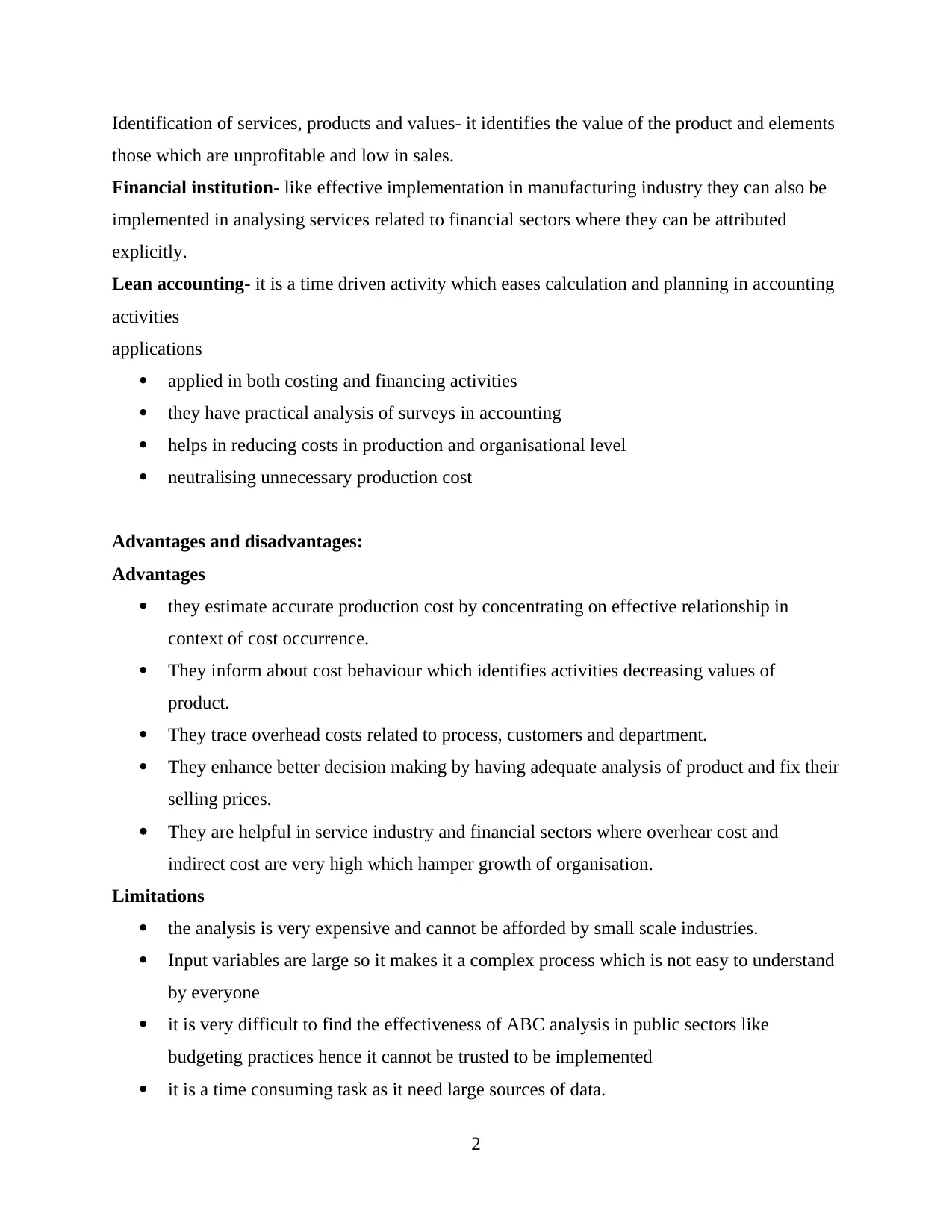
Identification of services, products and values- it identifies the value of the product and elements
those which are unprofitable and low in sales.
Financial institution- like effective implementation in manufacturing industry they can also be
implemented in analysing services related to financial sectors where they can be attributed
explicitly.
Lean accounting- it is a time driven activity which eases calculation and planning in accounting
activities
applications
applied in both costing and financing activities
they have practical analysis of surveys in accounting
helps in reducing costs in production and organisational level
neutralising unnecessary production cost
Advantages and disadvantages:
Advantages
they estimate accurate production cost by concentrating on effective relationship in
context of cost occurrence.
They inform about cost behaviour which identifies activities decreasing values of
product.
They trace overhead costs related to process, customers and department.
They enhance better decision making by having adequate analysis of product and fix their
selling prices.
They are helpful in service industry and financial sectors where overhear cost and
indirect cost are very high which hamper growth of organisation.
Limitations
the analysis is very expensive and cannot be afforded by small scale industries.
Input variables are large so it makes it a complex process which is not easy to understand
by everyone
it is very difficult to find the effectiveness of ABC analysis in public sectors like
budgeting practices hence it cannot be trusted to be implemented
it is a time consuming task as it need large sources of data.
2
those which are unprofitable and low in sales.
Financial institution- like effective implementation in manufacturing industry they can also be
implemented in analysing services related to financial sectors where they can be attributed
explicitly.
Lean accounting- it is a time driven activity which eases calculation and planning in accounting
activities
applications
applied in both costing and financing activities
they have practical analysis of surveys in accounting
helps in reducing costs in production and organisational level
neutralising unnecessary production cost
Advantages and disadvantages:
Advantages
they estimate accurate production cost by concentrating on effective relationship in
context of cost occurrence.
They inform about cost behaviour which identifies activities decreasing values of
product.
They trace overhead costs related to process, customers and department.
They enhance better decision making by having adequate analysis of product and fix their
selling prices.
They are helpful in service industry and financial sectors where overhear cost and
indirect cost are very high which hamper growth of organisation.
Limitations
the analysis is very expensive and cannot be afforded by small scale industries.
Input variables are large so it makes it a complex process which is not easy to understand
by everyone
it is very difficult to find the effectiveness of ABC analysis in public sectors like
budgeting practices hence it cannot be trusted to be implemented
it is a time consuming task as it need large sources of data.
2
Paraphrase This Document
Need a fresh take? Get an instant paraphrase of this document with our AI Paraphraser
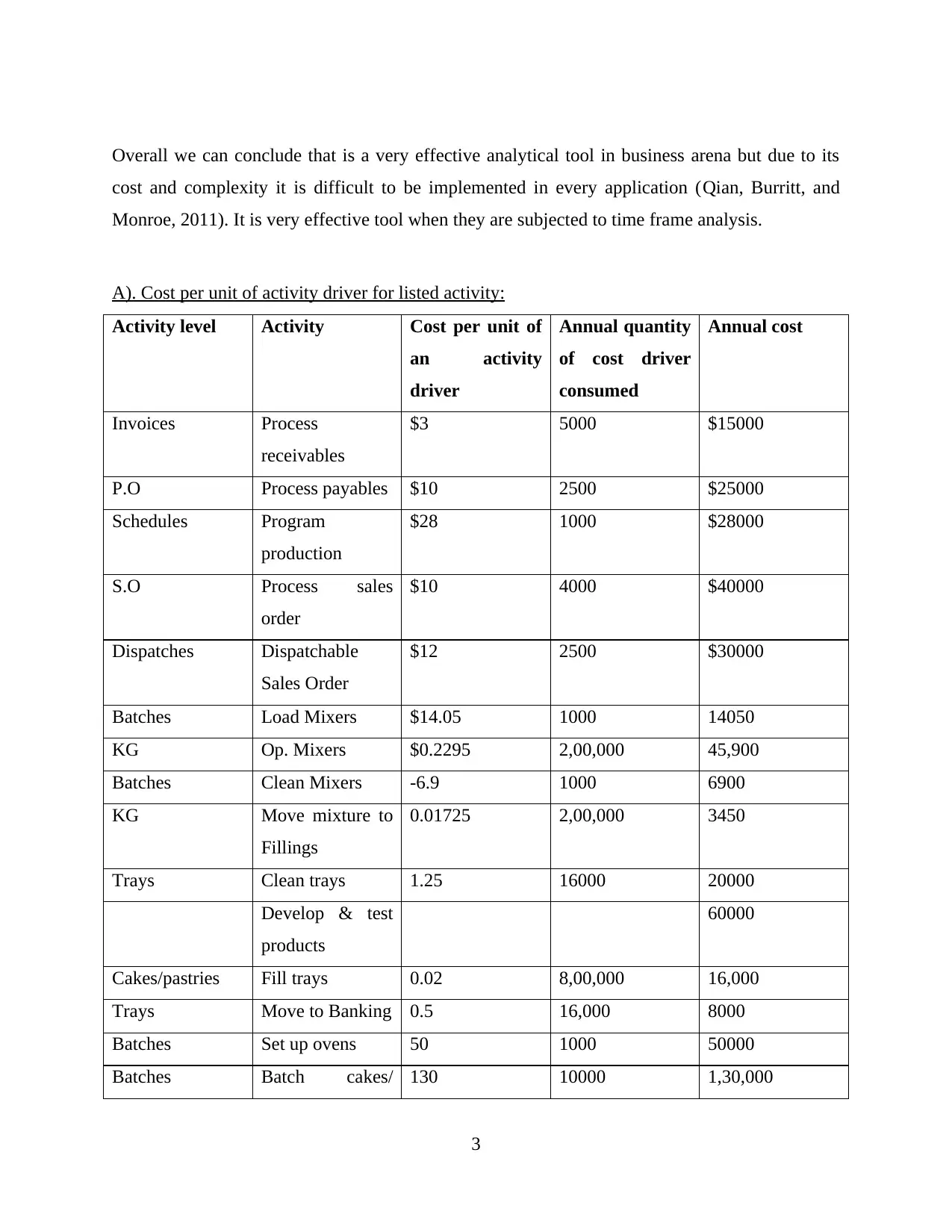
Overall we can conclude that is a very effective analytical tool in business arena but due to its
cost and complexity it is difficult to be implemented in every application (Qian, Burritt, and
Monroe, 2011). It is very effective tool when they are subjected to time frame analysis.
A). Cost per unit of activity driver for listed activity:
Activity level Activity Cost per unit of
an activity
driver
Annual quantity
of cost driver
consumed
Annual cost
Invoices Process
receivables
$3 5000 $15000
P.O Process payables $10 2500 $25000
Schedules Program
production
$28 1000 $28000
S.O Process sales
order
$10 4000 $40000
Dispatches Dispatchable
Sales Order
$12 2500 $30000
Batches Load Mixers $14.05 1000 14050
KG Op. Mixers $0.2295 2,00,000 45,900
Batches Clean Mixers -6.9 1000 6900
KG Move mixture to
Fillings
0.01725 2,00,000 3450
Trays Clean trays 1.25 16000 20000
Develop & test
products
60000
Cakes/pastries Fill trays 0.02 8,00,000 16,000
Trays Move to Banking 0.5 16,000 8000
Batches Set up ovens 50 1000 50000
Batches Batch cakes/ 130 10000 1,30,000
3
cost and complexity it is difficult to be implemented in every application (Qian, Burritt, and
Monroe, 2011). It is very effective tool when they are subjected to time frame analysis.
A). Cost per unit of activity driver for listed activity:
Activity level Activity Cost per unit of
an activity
driver
Annual quantity
of cost driver
consumed
Annual cost
Invoices Process
receivables
$3 5000 $15000
P.O Process payables $10 2500 $25000
Schedules Program
production
$28 1000 $28000
S.O Process sales
order
$10 4000 $40000
Dispatches Dispatchable
Sales Order
$12 2500 $30000
Batches Load Mixers $14.05 1000 14050
KG Op. Mixers $0.2295 2,00,000 45,900
Batches Clean Mixers -6.9 1000 6900
KG Move mixture to
Fillings
0.01725 2,00,000 3450
Trays Clean trays 1.25 16000 20000
Develop & test
products
60000
Cakes/pastries Fill trays 0.02 8,00,000 16,000
Trays Move to Banking 0.5 16,000 8000
Batches Set up ovens 50 1000 50000
Batches Batch cakes/ 130 10000 1,30,000
3
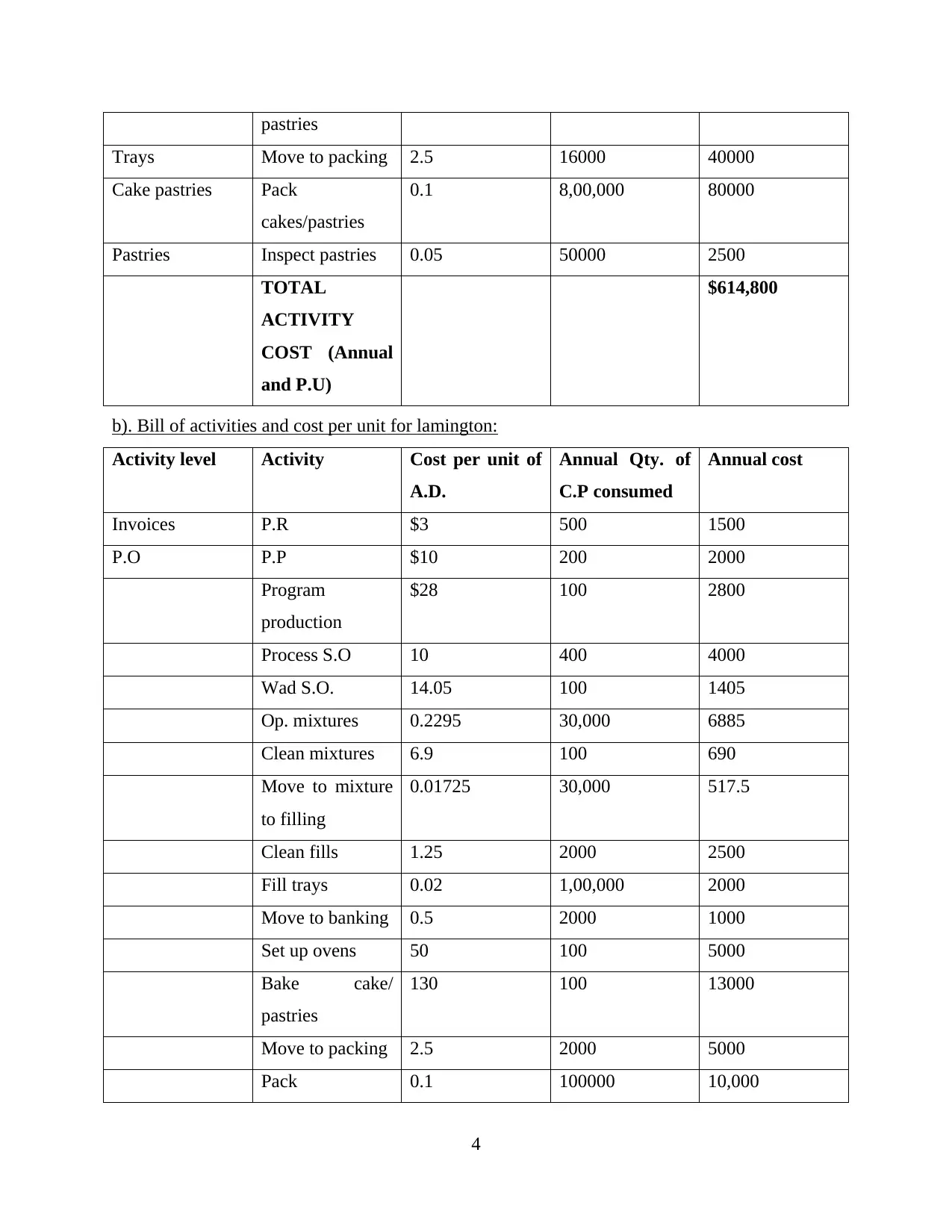
pastries
Trays Move to packing 2.5 16000 40000
Cake pastries Pack
cakes/pastries
0.1 8,00,000 80000
Pastries Inspect pastries 0.05 50000 2500
TOTAL
ACTIVITY
COST (Annual
and P.U)
$614,800
b). Bill of activities and cost per unit for lamington:
Activity level Activity Cost per unit of
A.D.
Annual Qty. of
C.P consumed
Annual cost
Invoices P.R $3 500 1500
P.O P.P $10 200 2000
Program
production
$28 100 2800
Process S.O 10 400 4000
Wad S.O. 14.05 100 1405
Op. mixtures 0.2295 30,000 6885
Clean mixtures 6.9 100 690
Move to mixture
to filling
0.01725 30,000 517.5
Clean fills 1.25 2000 2500
Fill trays 0.02 1,00,000 2000
Move to banking 0.5 2000 1000
Set up ovens 50 100 5000
Bake cake/
pastries
130 100 13000
Move to packing 2.5 2000 5000
Pack 0.1 100000 10,000
4
Trays Move to packing 2.5 16000 40000
Cake pastries Pack
cakes/pastries
0.1 8,00,000 80000
Pastries Inspect pastries 0.05 50000 2500
TOTAL
ACTIVITY
COST (Annual
and P.U)
$614,800
b). Bill of activities and cost per unit for lamington:
Activity level Activity Cost per unit of
A.D.
Annual Qty. of
C.P consumed
Annual cost
Invoices P.R $3 500 1500
P.O P.P $10 200 2000
Program
production
$28 100 2800
Process S.O 10 400 4000
Wad S.O. 14.05 100 1405
Op. mixtures 0.2295 30,000 6885
Clean mixtures 6.9 100 690
Move to mixture
to filling
0.01725 30,000 517.5
Clean fills 1.25 2000 2500
Fill trays 0.02 1,00,000 2000
Move to banking 0.5 2000 1000
Set up ovens 50 100 5000
Bake cake/
pastries
130 100 13000
Move to packing 2.5 2000 5000
Pack 0.1 100000 10,000
4
⊘ This is a preview!⊘
Do you want full access?
Subscribe today to unlock all pages.

Trusted by 1+ million students worldwide
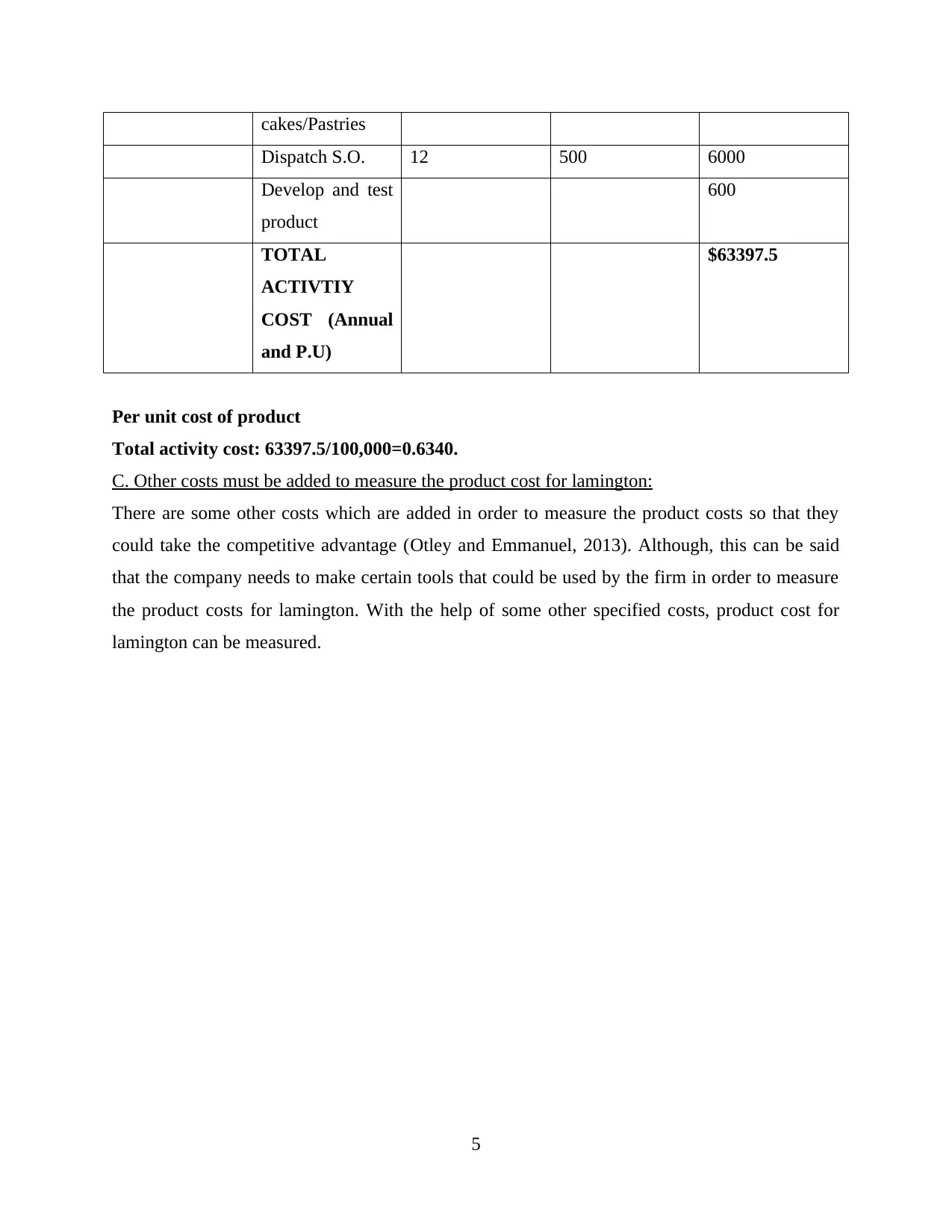
cakes/Pastries
Dispatch S.O. 12 500 6000
Develop and test
product
600
TOTAL
ACTIVTIY
COST (Annual
and P.U)
$63397.5
Per unit cost of product
Total activity cost: 63397.5/100,000=0.6340.
C. Other costs must be added to measure the product cost for lamington:
There are some other costs which are added in order to measure the product costs so that they
could take the competitive advantage (Otley and Emmanuel, 2013). Although, this can be said
that the company needs to make certain tools that could be used by the firm in order to measure
the product costs for lamington. With the help of some other specified costs, product cost for
lamington can be measured.
5
Dispatch S.O. 12 500 6000
Develop and test
product
600
TOTAL
ACTIVTIY
COST (Annual
and P.U)
$63397.5
Per unit cost of product
Total activity cost: 63397.5/100,000=0.6340.
C. Other costs must be added to measure the product cost for lamington:
There are some other costs which are added in order to measure the product costs so that they
could take the competitive advantage (Otley and Emmanuel, 2013). Although, this can be said
that the company needs to make certain tools that could be used by the firm in order to measure
the product costs for lamington. With the help of some other specified costs, product cost for
lamington can be measured.
5
Paraphrase This Document
Need a fresh take? Get an instant paraphrase of this document with our AI Paraphraser
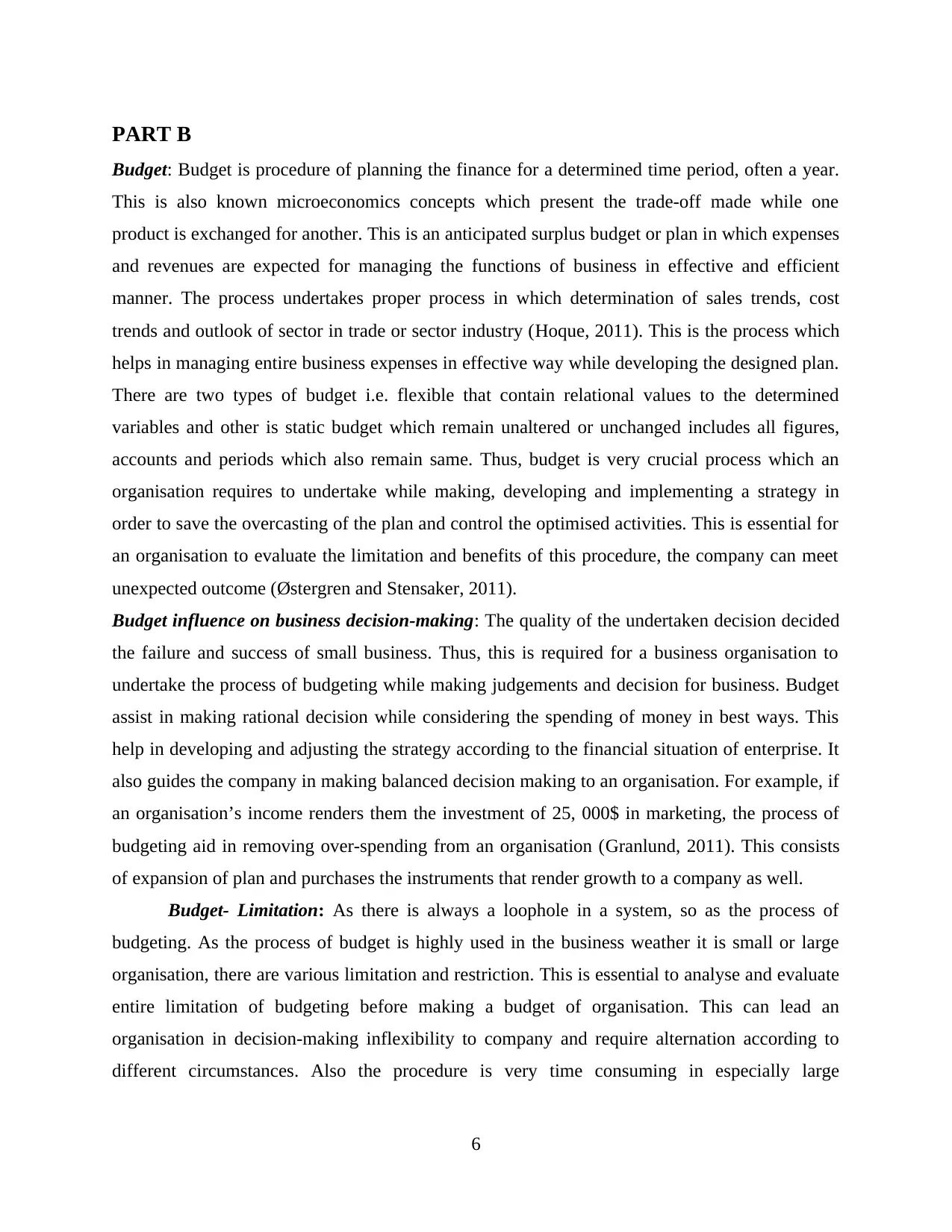
PART B
Budget: Budget is procedure of planning the finance for a determined time period, often a year.
This is also known microeconomics concepts which present the trade-off made while one
product is exchanged for another. This is an anticipated surplus budget or plan in which expenses
and revenues are expected for managing the functions of business in effective and efficient
manner. The process undertakes proper process in which determination of sales trends, cost
trends and outlook of sector in trade or sector industry (Hoque, 2011). This is the process which
helps in managing entire business expenses in effective way while developing the designed plan.
There are two types of budget i.e. flexible that contain relational values to the determined
variables and other is static budget which remain unaltered or unchanged includes all figures,
accounts and periods which also remain same. Thus, budget is very crucial process which an
organisation requires to undertake while making, developing and implementing a strategy in
order to save the overcasting of the plan and control the optimised activities. This is essential for
an organisation to evaluate the limitation and benefits of this procedure, the company can meet
unexpected outcome (Østergren and Stensaker, 2011).
Budget influence on business decision-making: The quality of the undertaken decision decided
the failure and success of small business. Thus, this is required for a business organisation to
undertake the process of budgeting while making judgements and decision for business. Budget
assist in making rational decision while considering the spending of money in best ways. This
help in developing and adjusting the strategy according to the financial situation of enterprise. It
also guides the company in making balanced decision making to an organisation. For example, if
an organisation’s income renders them the investment of 25, 000$ in marketing, the process of
budgeting aid in removing over-spending from an organisation (Granlund, 2011). This consists
of expansion of plan and purchases the instruments that render growth to a company as well.
Budget- Limitation: As there is always a loophole in a system, so as the process of
budgeting. As the process of budget is highly used in the business weather it is small or large
organisation, there are various limitation and restriction. This is essential to analyse and evaluate
entire limitation of budgeting before making a budget of organisation. This can lead an
organisation in decision-making inflexibility to company and require alternation according to
different circumstances. Also the procedure is very time consuming in especially large
6
Budget: Budget is procedure of planning the finance for a determined time period, often a year.
This is also known microeconomics concepts which present the trade-off made while one
product is exchanged for another. This is an anticipated surplus budget or plan in which expenses
and revenues are expected for managing the functions of business in effective and efficient
manner. The process undertakes proper process in which determination of sales trends, cost
trends and outlook of sector in trade or sector industry (Hoque, 2011). This is the process which
helps in managing entire business expenses in effective way while developing the designed plan.
There are two types of budget i.e. flexible that contain relational values to the determined
variables and other is static budget which remain unaltered or unchanged includes all figures,
accounts and periods which also remain same. Thus, budget is very crucial process which an
organisation requires to undertake while making, developing and implementing a strategy in
order to save the overcasting of the plan and control the optimised activities. This is essential for
an organisation to evaluate the limitation and benefits of this procedure, the company can meet
unexpected outcome (Østergren and Stensaker, 2011).
Budget influence on business decision-making: The quality of the undertaken decision decided
the failure and success of small business. Thus, this is required for a business organisation to
undertake the process of budgeting while making judgements and decision for business. Budget
assist in making rational decision while considering the spending of money in best ways. This
help in developing and adjusting the strategy according to the financial situation of enterprise. It
also guides the company in making balanced decision making to an organisation. For example, if
an organisation’s income renders them the investment of 25, 000$ in marketing, the process of
budgeting aid in removing over-spending from an organisation (Granlund, 2011). This consists
of expansion of plan and purchases the instruments that render growth to a company as well.
Budget- Limitation: As there is always a loophole in a system, so as the process of
budgeting. As the process of budget is highly used in the business weather it is small or large
organisation, there are various limitation and restriction. This is essential to analyse and evaluate
entire limitation of budgeting before making a budget of organisation. This can lead an
organisation in decision-making inflexibility to company and require alternation according to
different circumstances. Also the procedure is very time consuming in especially large
6
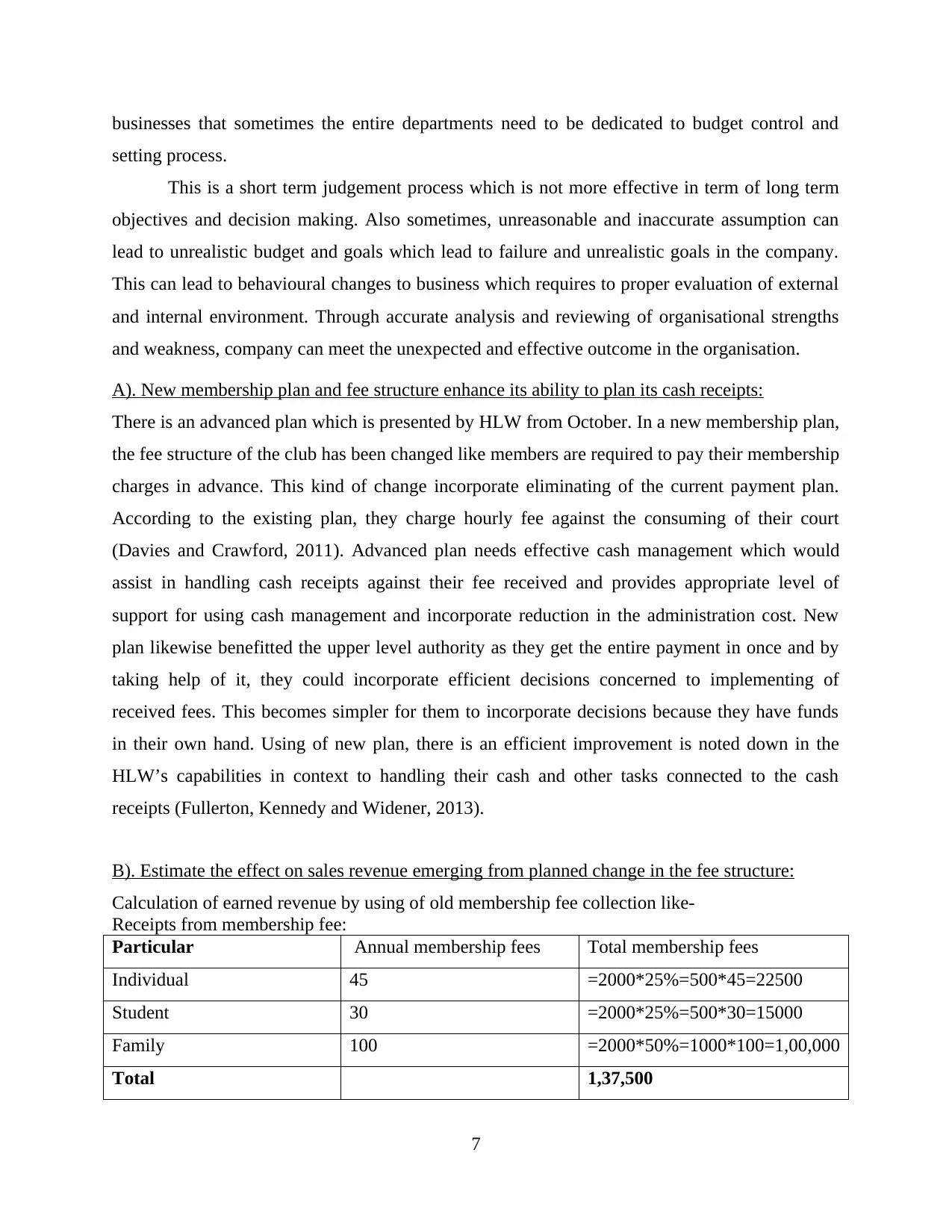
businesses that sometimes the entire departments need to be dedicated to budget control and
setting process.
This is a short term judgement process which is not more effective in term of long term
objectives and decision making. Also sometimes, unreasonable and inaccurate assumption can
lead to unrealistic budget and goals which lead to failure and unrealistic goals in the company.
This can lead to behavioural changes to business which requires to proper evaluation of external
and internal environment. Through accurate analysis and reviewing of organisational strengths
and weakness, company can meet the unexpected and effective outcome in the organisation.
A). New membership plan and fee structure enhance its ability to plan its cash receipts:
There is an advanced plan which is presented by HLW from October. In a new membership plan,
the fee structure of the club has been changed like members are required to pay their membership
charges in advance. This kind of change incorporate eliminating of the current payment plan.
According to the existing plan, they charge hourly fee against the consuming of their court
(Davies and Crawford, 2011). Advanced plan needs effective cash management which would
assist in handling cash receipts against their fee received and provides appropriate level of
support for using cash management and incorporate reduction in the administration cost. New
plan likewise benefitted the upper level authority as they get the entire payment in once and by
taking help of it, they could incorporate efficient decisions concerned to implementing of
received fees. This becomes simpler for them to incorporate decisions because they have funds
in their own hand. Using of new plan, there is an efficient improvement is noted down in the
HLW’s capabilities in context to handling their cash and other tasks connected to the cash
receipts (Fullerton, Kennedy and Widener, 2013).
B). Estimate the effect on sales revenue emerging from planned change in the fee structure:
Calculation of earned revenue by using of old membership fee collection like-
Receipts from membership fee:
Particular Annual membership fees Total membership fees
Individual 45 =2000*25%=500*45=22500
Student 30 =2000*25%=500*30=15000
Family 100 =2000*50%=1000*100=1,00,000
Total 1,37,500
7
setting process.
This is a short term judgement process which is not more effective in term of long term
objectives and decision making. Also sometimes, unreasonable and inaccurate assumption can
lead to unrealistic budget and goals which lead to failure and unrealistic goals in the company.
This can lead to behavioural changes to business which requires to proper evaluation of external
and internal environment. Through accurate analysis and reviewing of organisational strengths
and weakness, company can meet the unexpected and effective outcome in the organisation.
A). New membership plan and fee structure enhance its ability to plan its cash receipts:
There is an advanced plan which is presented by HLW from October. In a new membership plan,
the fee structure of the club has been changed like members are required to pay their membership
charges in advance. This kind of change incorporate eliminating of the current payment plan.
According to the existing plan, they charge hourly fee against the consuming of their court
(Davies and Crawford, 2011). Advanced plan needs effective cash management which would
assist in handling cash receipts against their fee received and provides appropriate level of
support for using cash management and incorporate reduction in the administration cost. New
plan likewise benefitted the upper level authority as they get the entire payment in once and by
taking help of it, they could incorporate efficient decisions concerned to implementing of
received fees. This becomes simpler for them to incorporate decisions because they have funds
in their own hand. Using of new plan, there is an efficient improvement is noted down in the
HLW’s capabilities in context to handling their cash and other tasks connected to the cash
receipts (Fullerton, Kennedy and Widener, 2013).
B). Estimate the effect on sales revenue emerging from planned change in the fee structure:
Calculation of earned revenue by using of old membership fee collection like-
Receipts from membership fee:
Particular Annual membership fees Total membership fees
Individual 45 =2000*25%=500*45=22500
Student 30 =2000*25%=500*30=15000
Family 100 =2000*50%=1000*100=1,00,000
Total 1,37,500
7
⊘ This is a preview!⊘
Do you want full access?
Subscribe today to unlock all pages.

Trusted by 1+ million students worldwide
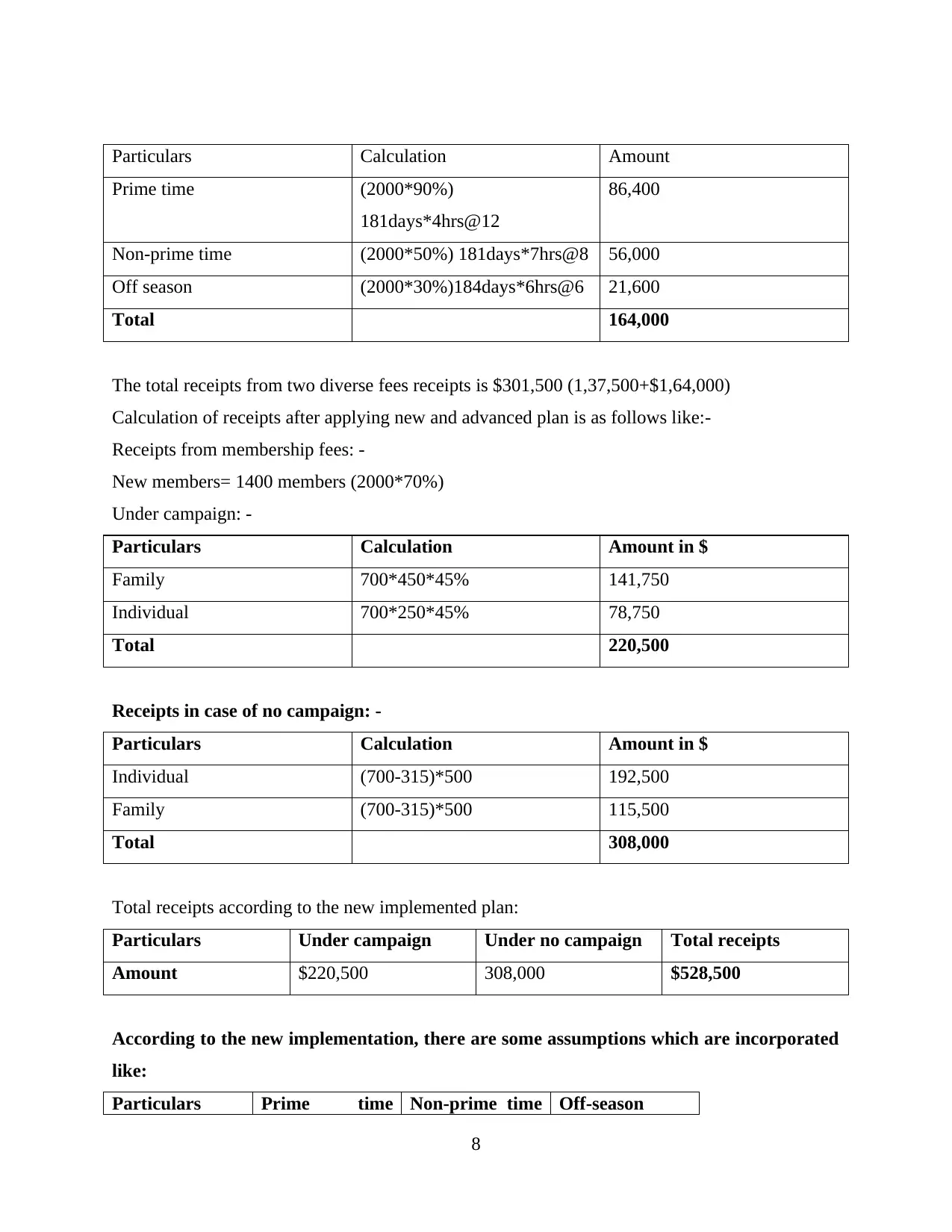
Particulars Calculation Amount
Prime time (2000*90%)
181days*4hrs@12
86,400
Non-prime time (2000*50%) 181days*7hrs@8 56,000
Off season (2000*30%)184days*6hrs@6 21,600
Total 164,000
The total receipts from two diverse fees receipts is $301,500 (1,37,500+$1,64,000)
Calculation of receipts after applying new and advanced plan is as follows like:-
Receipts from membership fees: -
New members= 1400 members (2000*70%)
Under campaign: -
Particulars Calculation Amount in $
Family 700*450*45% 141,750
Individual 700*250*45% 78,750
Total 220,500
Receipts in case of no campaign: -
Particulars Calculation Amount in $
Individual (700-315)*500 192,500
Family (700-315)*500 115,500
Total 308,000
Total receipts according to the new implemented plan:
Particulars Under campaign Under no campaign Total receipts
Amount $220,500 308,000 $528,500
According to the new implementation, there are some assumptions which are incorporated
like:
Particulars Prime time Non-prime time Off-season
8
Prime time (2000*90%)
181days*4hrs@12
86,400
Non-prime time (2000*50%) 181days*7hrs@8 56,000
Off season (2000*30%)184days*6hrs@6 21,600
Total 164,000
The total receipts from two diverse fees receipts is $301,500 (1,37,500+$1,64,000)
Calculation of receipts after applying new and advanced plan is as follows like:-
Receipts from membership fees: -
New members= 1400 members (2000*70%)
Under campaign: -
Particulars Calculation Amount in $
Family 700*450*45% 141,750
Individual 700*250*45% 78,750
Total 220,500
Receipts in case of no campaign: -
Particulars Calculation Amount in $
Individual (700-315)*500 192,500
Family (700-315)*500 115,500
Total 308,000
Total receipts according to the new implemented plan:
Particulars Under campaign Under no campaign Total receipts
Amount $220,500 308,000 $528,500
According to the new implementation, there are some assumptions which are incorporated
like:
Particulars Prime time Non-prime time Off-season
8
Paraphrase This Document
Need a fresh take? Get an instant paraphrase of this document with our AI Paraphraser
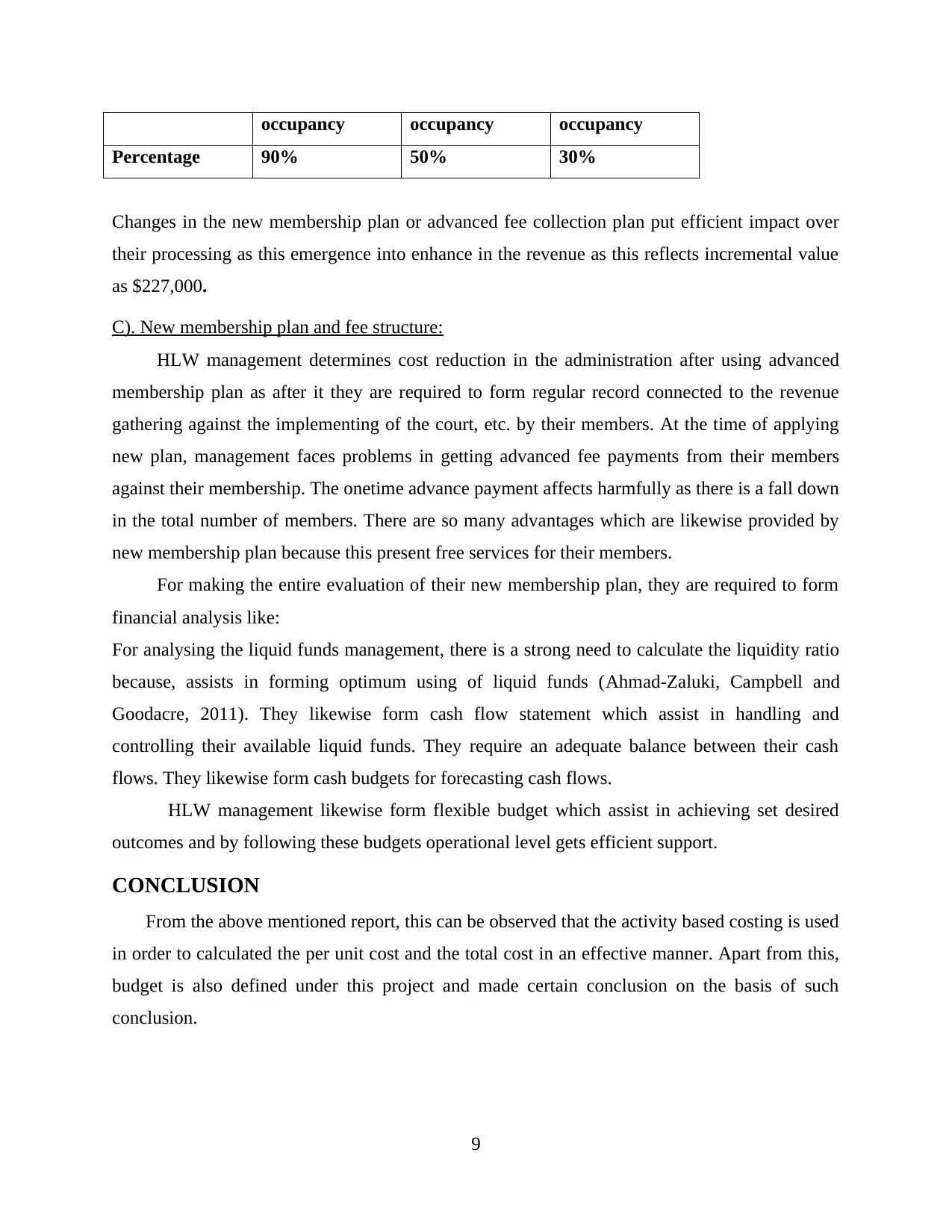
occupancy occupancy occupancy
Percentage 90% 50% 30%
Changes in the new membership plan or advanced fee collection plan put efficient impact over
their processing as this emergence into enhance in the revenue as this reflects incremental value
as $227,000.
C). New membership plan and fee structure:
HLW management determines cost reduction in the administration after using advanced
membership plan as after it they are required to form regular record connected to the revenue
gathering against the implementing of the court, etc. by their members. At the time of applying
new plan, management faces problems in getting advanced fee payments from their members
against their membership. The onetime advance payment affects harmfully as there is a fall down
in the total number of members. There are so many advantages which are likewise provided by
new membership plan because this present free services for their members.
For making the entire evaluation of their new membership plan, they are required to form
financial analysis like:
For analysing the liquid funds management, there is a strong need to calculate the liquidity ratio
because, assists in forming optimum using of liquid funds (Ahmad-Zaluki, Campbell and
Goodacre, 2011). They likewise form cash flow statement which assist in handling and
controlling their available liquid funds. They require an adequate balance between their cash
flows. They likewise form cash budgets for forecasting cash flows.
HLW management likewise form flexible budget which assist in achieving set desired
outcomes and by following these budgets operational level gets efficient support.
CONCLUSION
From the above mentioned report, this can be observed that the activity based costing is used
in order to calculated the per unit cost and the total cost in an effective manner. Apart from this,
budget is also defined under this project and made certain conclusion on the basis of such
conclusion.
9
Percentage 90% 50% 30%
Changes in the new membership plan or advanced fee collection plan put efficient impact over
their processing as this emergence into enhance in the revenue as this reflects incremental value
as $227,000.
C). New membership plan and fee structure:
HLW management determines cost reduction in the administration after using advanced
membership plan as after it they are required to form regular record connected to the revenue
gathering against the implementing of the court, etc. by their members. At the time of applying
new plan, management faces problems in getting advanced fee payments from their members
against their membership. The onetime advance payment affects harmfully as there is a fall down
in the total number of members. There are so many advantages which are likewise provided by
new membership plan because this present free services for their members.
For making the entire evaluation of their new membership plan, they are required to form
financial analysis like:
For analysing the liquid funds management, there is a strong need to calculate the liquidity ratio
because, assists in forming optimum using of liquid funds (Ahmad-Zaluki, Campbell and
Goodacre, 2011). They likewise form cash flow statement which assist in handling and
controlling their available liquid funds. They require an adequate balance between their cash
flows. They likewise form cash budgets for forecasting cash flows.
HLW management likewise form flexible budget which assist in achieving set desired
outcomes and by following these budgets operational level gets efficient support.
CONCLUSION
From the above mentioned report, this can be observed that the activity based costing is used
in order to calculated the per unit cost and the total cost in an effective manner. Apart from this,
budget is also defined under this project and made certain conclusion on the basis of such
conclusion.
9
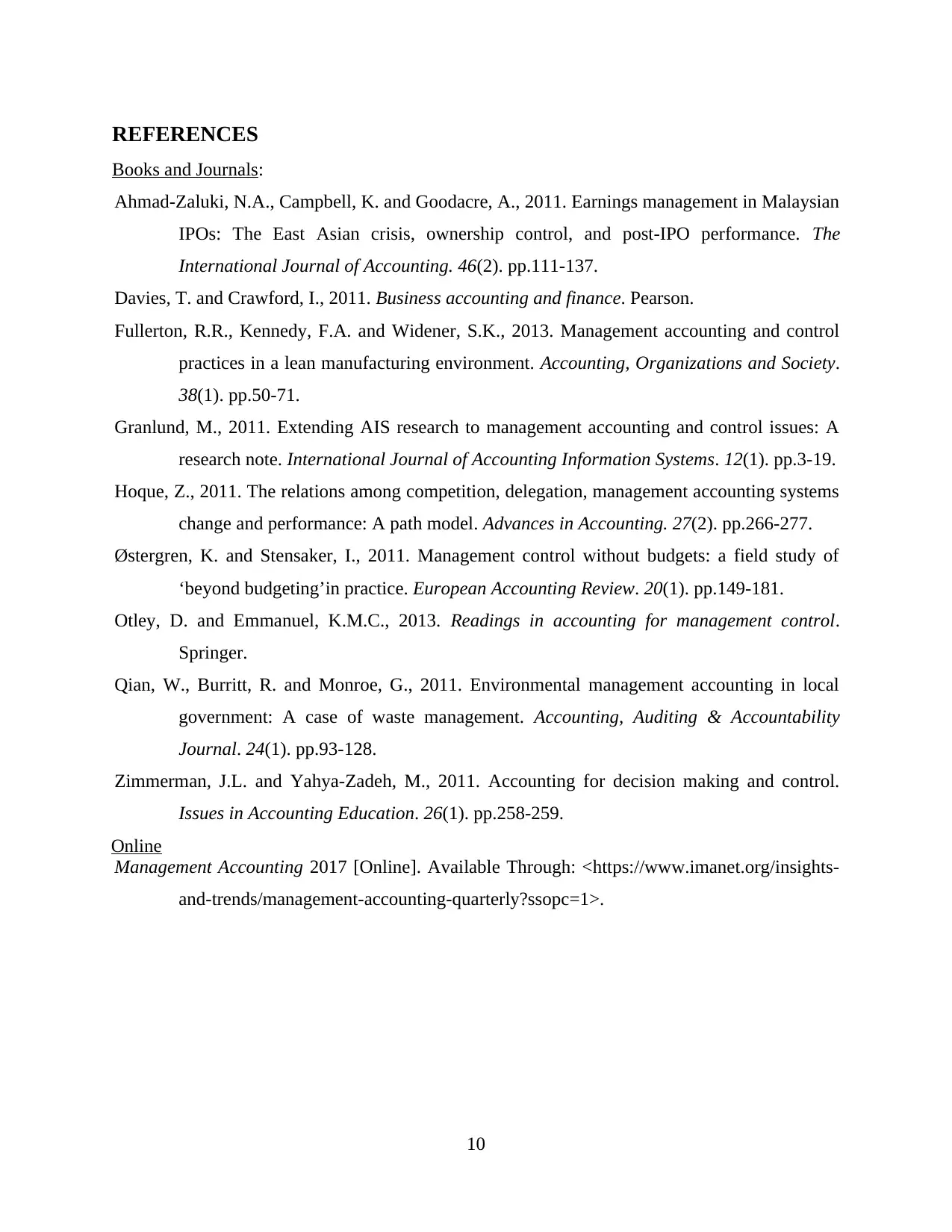
REFERENCES
Books and Journals:
Ahmad-Zaluki, N.A., Campbell, K. and Goodacre, A., 2011. Earnings management in Malaysian
IPOs: The East Asian crisis, ownership control, and post-IPO performance. The
International Journal of Accounting. 46(2). pp.111-137.
Davies, T. and Crawford, I., 2011. Business accounting and finance. Pearson.
Fullerton, R.R., Kennedy, F.A. and Widener, S.K., 2013. Management accounting and control
practices in a lean manufacturing environment. Accounting, Organizations and Society.
38(1). pp.50-71.
Granlund, M., 2011. Extending AIS research to management accounting and control issues: A
research note. International Journal of Accounting Information Systems. 12(1). pp.3-19.
Hoque, Z., 2011. The relations among competition, delegation, management accounting systems
change and performance: A path model. Advances in Accounting. 27(2). pp.266-277.
Østergren, K. and Stensaker, I., 2011. Management control without budgets: a field study of
‘beyond budgeting’in practice. European Accounting Review. 20(1). pp.149-181.
Otley, D. and Emmanuel, K.M.C., 2013. Readings in accounting for management control.
Springer.
Qian, W., Burritt, R. and Monroe, G., 2011. Environmental management accounting in local
government: A case of waste management. Accounting, Auditing & Accountability
Journal. 24(1). pp.93-128.
Zimmerman, J.L. and Yahya-Zadeh, M., 2011. Accounting for decision making and control.
Issues in Accounting Education. 26(1). pp.258-259.
Online
Management Accounting 2017 [Online]. Available Through: <https://www.imanet.org/insights-
and-trends/management-accounting-quarterly?ssopc=1>.
10
Books and Journals:
Ahmad-Zaluki, N.A., Campbell, K. and Goodacre, A., 2011. Earnings management in Malaysian
IPOs: The East Asian crisis, ownership control, and post-IPO performance. The
International Journal of Accounting. 46(2). pp.111-137.
Davies, T. and Crawford, I., 2011. Business accounting and finance. Pearson.
Fullerton, R.R., Kennedy, F.A. and Widener, S.K., 2013. Management accounting and control
practices in a lean manufacturing environment. Accounting, Organizations and Society.
38(1). pp.50-71.
Granlund, M., 2011. Extending AIS research to management accounting and control issues: A
research note. International Journal of Accounting Information Systems. 12(1). pp.3-19.
Hoque, Z., 2011. The relations among competition, delegation, management accounting systems
change and performance: A path model. Advances in Accounting. 27(2). pp.266-277.
Østergren, K. and Stensaker, I., 2011. Management control without budgets: a field study of
‘beyond budgeting’in practice. European Accounting Review. 20(1). pp.149-181.
Otley, D. and Emmanuel, K.M.C., 2013. Readings in accounting for management control.
Springer.
Qian, W., Burritt, R. and Monroe, G., 2011. Environmental management accounting in local
government: A case of waste management. Accounting, Auditing & Accountability
Journal. 24(1). pp.93-128.
Zimmerman, J.L. and Yahya-Zadeh, M., 2011. Accounting for decision making and control.
Issues in Accounting Education. 26(1). pp.258-259.
Online
Management Accounting 2017 [Online]. Available Through: <https://www.imanet.org/insights-
and-trends/management-accounting-quarterly?ssopc=1>.
10
⊘ This is a preview!⊘
Do you want full access?
Subscribe today to unlock all pages.

Trusted by 1+ million students worldwide
1 out of 12
Related Documents
Your All-in-One AI-Powered Toolkit for Academic Success.
+13062052269
info@desklib.com
Available 24*7 on WhatsApp / Email
![[object Object]](/_next/static/media/star-bottom.7253800d.svg)
Unlock your academic potential
Copyright © 2020–2025 A2Z Services. All Rights Reserved. Developed and managed by ZUCOL.




